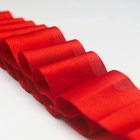Satin is a lustrous fabric with a smooth, sleek surface. The high gloss is created by a weave that leaves moderately long lengths of polished, uninterrupted thread on the surface of the cloth. Water stains on satin are caused by the water soaking the fibers, altering the outer texture of the polish in relation to the other threads. Minerals in solution in the water can also alter the sheen.
Modern satins are made from a wide array of fibers. As a result there are a number of approaches to coping with water stains on satin.
What Is Your Satin Made From?
Where once satin was made only of silk, today satins are made from many fibers. Before you can decide how to deal with a water stain on satin, you must determine what the satin is made from and whether there are cleaning instructions on the garment. If the dress is marked dry clean only, it is wisest to take it to a dry cleaner with a good professional reputation and bring the spotting to the attention of the service.
Your Satin Can Be Washed.
If your satin is of a washable fiber but has no further instructions, then wash in lukewarm water, using a mild cleaner for delicate fabrics. Hand washing is best. Use as little agitation as possible and do not squish, squeeze or crush the fabric. Keep the fabric as loose and smooth as possible in a large volume of water: For a dress you may choose a bathtub rather than a sink to ensure that the fabric can almost float in the water, rather than be bunched up. Remember the sheen from the fabric is caused by smooth, highly polished threads lined up neatly; crushing the fabric will alter the line of the threads and damage the high polish.
Rinsing.
When you have completed a soft, gentle-handed wash of the satin, drain the sink or tub, letting the water drain away without putting any pressure on the fabric or wringing it out. Close the drain and gently fill the tub again with room-temperature water. Move the water gently in the tub and slide your hands under the satin, lifting and sliding the fabric to help rinse out any remaining fabric cleaner.
Drying and Ironing.
When you have rinsed the satin dress, allow the water to once more drain from the tub. Remove the dress gently and hang from a clean plastic hanger padded over the shoulders with clean, white dish cloths, pillow cases or hand towels. Allow the dress to drip dry. When it has dried it can be ironed, gently, using a low heat setting, no steam, with the garment turned inside out. If you wish, you can even place a soft sheet under the garment to help pad the threads. Even from the reverse, try to iron in the direction of the flow of the satin-shine threads to avoid disturbing the even surface of the fabric.
Related Articles

How to Clean a Taffeta Dress

How to Wash a Velvet Dress

Care of Satin Fabric

Can You Hand Wash Silk That Says Dry ...

How to Clean a Wedding Dress at Home

How to Clean Viscose Shawls

How Can I Get a Stain Out of a Silk ...

How to Remove Creases From Sweaters

Steaming a Chiffon Wedding Dress

Care Instructions for Voile Fabric

How to Get Rid of Yellow Age Spots on ...

The Disadvantages of Rayon Fabric

The Care of Plisse Fabric

How to Make My Yellowed Wedding Dress ...

How to Get Rid of Perspiration Stains ...

How to Iron a Chiffon Dress

How do I Clean Silk Ribbon?

How to Remove Wrinkles From Polyester ...

How to Soften Stiff, Starchy Material

How to Iron Silk Dupioni
References
Writer Bio
Peg Robinson's first sale was in Pocket Books' 1999 "Strange New Worlds." Her credits include award-winning "Helixsf," and "Cicada Magazine." Her novela, "Tonino and the Incubus," qualified for the 2007 Nebulas. She graduated with honors in religious studies from UCSB. She's currently in an M.A./Ph.D. program in mythological studies at Pacifica Graduate Institute.